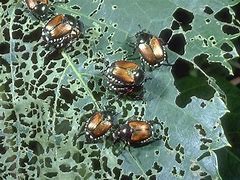Return of the Japanese Beetles
“The Return of the Japanese Beetles” sounds like a horror movie. But unfortunately, these beetles have returned to devour our landscapes for another summer of terror.
The Japanese beetle is believed to have originated in Japan and was first noticed in the eastern United States in the New Jersey area in the early 1900s. The beetles were most likely introduced in the United States through commerce, and they were able to thrive due largely to the eastern U.S. being able to provide a favorable climate, large areas of grass for developing grubs, hundreds of species of plants on which adults could feed and no effective natural enemies.
Appearance

Courtesy of Pest.org
Japanese Beetles are ½ inch in length with metallic blue-green heads, copper-colored backs, tan wings, and small white hairs lining each side of the abdomen. Japanese beetles usually feed in small groups.
Activity
Japanese beetles are most active on warm, sunny days, and prefer plants that are in direct sunlight. Adults feed on the leaves and flowers of the food source. This gives the leaf a “skeletonized” appearance. Adult Japanese beetles are very transient and can infest new areas from several miles away whether it is from a wind shift, new introduction, or food source availability. The adults also are active fliers and can be observed flying around the yard and plants. Typically, they stay close to the areas that have the most plentiful supply of plant species that fit their feeding habits so that they can breed and lay eggs.

Courtesy of The Old Farmer’s Almanac
Adults appear from the ground and begin feeding on plants in the early summer. The peak of their activity lasts from late June through August or September when they will begin to die off due to temperature and climate. Japanese beetles live for up to two months during their adult life form.
How Do They Reproduce
Adults dig their way out of the soil and mate in the summer. Eggs are laid by the female in short burrows they dig in the soil. She can lay between 40 to 60 eggs in her life. The larvae, called grubs, feed on roots in the soil and will pass the winter in a dormant state. In spring, they resume feeding and ultimately transform into adults by the summer.
Are Japanese Beetles a Serious Problem?
This beetle feeds on a wide variety of plants and crops while the larvae or grubs, will feed on a variety of roots of ornamental trees, shrubs, garden plants and grass. They are commonly known to cause a multitude of damage to a variety of plants. The feeding habits of Japanese beetles are what make them such a nuisance. They are opportunistic feeders and have been documented to feed on over 300 types of plants and crops. They also like to feed in groups, which causes them to do damage to a wide area if the food source that attracts them is available.
The scents of some kinds of flowers, fruits, and plants, as well as the pheromones (chemical scent) of other Japanese beetles, lure these pests onto almost any yard with large, open patches of grass. Certain kinds of plants are more likely to attract Japanese beetles. Black walnut, apple, cherry and linden trees as well as grapes, plums, roses, and hollyhocks are favorite meals. In contrast, trees in the maple, oak and coniferous species groups are rarely, if ever feed upon by Japanese beetles.
How Can You Get Rid of Them?
From an extermination standpoint, it is important to recognize that both the adults and grubs can cause damage. Therefore, a combination of behavioral, mechanical and chemical controls should be considered. Since Japanese beetles are capable of traveling from nearby areas or neighboring plants, control measures of the different life stages must be taken into consideration to eliminate the infestation. Control of the grub or larval stage requires properly timed applications of a soil insecticide to infested areas.
Behavioral and physical controls would consist of habitat modification (planting plants that are less attractive to Japanese beetle adults) and physical removal of plants and/or the adult beetles by shaking them off early in the morning when the insects are sluggish. The beetles may be easily killed by shaking them into a bucket of soapy water.
Mechanical controls are applied through the use of traps with pheromone lures; however, this will not correct any issues with grub infestations and can attract more beetles to the area.
Control of Japanese Beetles Using Traps
Japanese beetle traps are sold in many garden and home improvement centers and aid in the control and extermination of these pests. However, it should be noted that traps will only help prevent the adults from feeding on certain plants and shrubs. Along with using traps to control the adult population, some sort of lawn maintenance program to control the larvae, or grubs, should be executed as well.
Commercially available traps attract the beetles with two types of baits or pheromones. Pheromones are chemical substances that are released by insects or other organisms into the environment to communicate with others of the same species. However, these types of attractants are so powerful that they can literally draw in thousands of beetles per day. Traps attract many more beetles than are actually caught. Therefore, plants along the ‘flight path’ of the beetles and in the area of traps are likely to suffer much more damage than if no traps are used at all. You should carefully consider whether to use a trap as a means of control or seek out other cultural (habitat modification) or physical (removal by hand) controls.
SEASONAL NOTE:
In Mid-July – August you may have swarms of the Japanese beetles fly toward the home at dusk. In some cases, we get reports of mass swarms to the eaves of chimneys. If this happens, don’t be alarmed this is just part of the life cycle of this insect.
